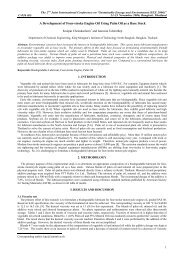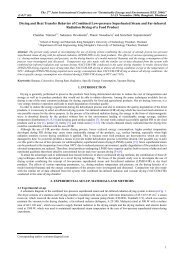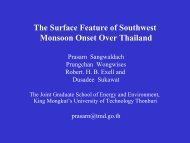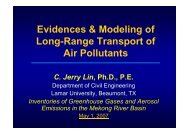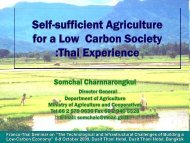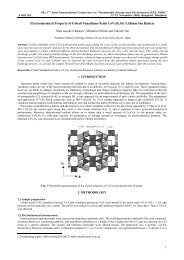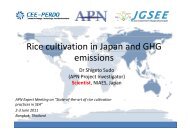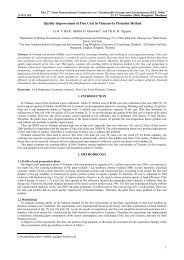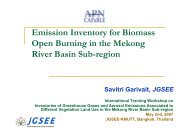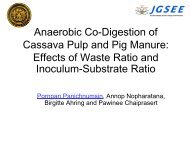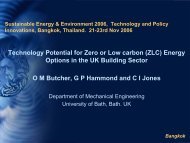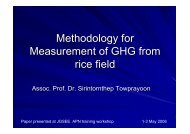Seasonal Variation of Landfill Methane Emissions from ... - JGSEE
Seasonal Variation of Landfill Methane Emissions from ... - JGSEE
Seasonal Variation of Landfill Methane Emissions from ... - JGSEE
Create successful ePaper yourself
Turn your PDF publications into a flip-book with our unique Google optimized e-Paper software.
The 2 nd Joint International Conference on “Sustainable Energy and Environment (SEE 2006)”<br />
D-026 (O) 21-23 November 2006, Bangkok, Thailand<br />
3.2 <strong>Methane</strong> generation rate<br />
The study site’s information including L o , disposal area and waste disposal history were used to evaluate the value <strong>of</strong> k by fit with<br />
experimental data in the Mexico LFG Model. The obtained values <strong>of</strong> k are summarized in Table 3. It is clear that the values <strong>of</strong> k are<br />
higher in wet season than dry season by about 7.5 – 9.6 times for landfills but varied between 2.1 – 11.5 times for open dump sites.<br />
Table 3 The obtained value <strong>of</strong> methane generation rate (k)<br />
Site <strong>Landfill</strong>ing Condition k-wet season (yr -1 ) k-dry season (yr -1 )<br />
Pattaya Managed - Deep 0.192 0.020<br />
Cha-Am Managed - Shallow 0.040 0.005<br />
Nakornprathom Unmanaged - Deep 0.005 0.002<br />
Hua-Hin Managed - Deep 0.138 0.016<br />
Nontaburi Unmanaged - Deep 0.0003 0.0001<br />
Rayong Unmanaged - Shallow 0.013 0.004<br />
Samutprakan Unmanaged - Deep 0.013 0.001<br />
4. CONCLUSION<br />
Measurements for methane emission were performed at seven solid waste disposal sites, located in central Thailand including 3<br />
sanitary landfills, and 4 open dumps. 88.4% <strong>of</strong> sampling runs fulfilled the R 2 >0.5 criterion for dC/dt (75% had values <strong>of</strong> R 2 > 0.9).<br />
The spatial variability <strong>of</strong> the local emissions in wet season is quite high (ranging between 0 – 825.79 g/m 2 /d) but the average spatial<br />
emissions ranged between 5.45 – 129.79 g/m 2 /d. The spatial variability <strong>of</strong> the local emissions in dry season is lower than emissions in<br />
wet season (ranging between 0 – 686.93 g/m 2 /d) but the average spatial emissions ranged between 1.00 – 23.40 g/m 2 /d. The obtained<br />
values <strong>of</strong> k that used for methane emissions calculation ranged <strong>from</strong> 0.04000 – 0.19200 and 0.00530 – 0.02000 in landfills for wet<br />
season and dry season, respectively. The obtained values <strong>of</strong> k for open dump sites ranged <strong>from</strong> 0.00030 – 0.01340 and 0.00012 –<br />
0.00420 for wet season and dry season, respectively. The emissions in wet season are much higher than dry season. The moisture<br />
content in waste disposal body might be the main cause for these phenomena.<br />
6. REFERENCES<br />
[1] Khalil, M., (1999) Non-CO2 greenhouse gases in the atmosphere, Annu Rev Energy Environ, 24, pp. 645 – 661.<br />
[2] Nastev, M., Therrien, R., Lefebvre, R. and Gelinas, P. (2001) Gas production and mitigation in landfills and geological materials,<br />
J. Contaminant Hydrology, 52, pp. 187-211.<br />
[3] Humer, M. and Lechner, P. (1999) Alternative approach to the elimination <strong>of</strong> greenhouse gases <strong>from</strong> old landfills, Waste<br />
management research, 17, pp. 443-452.<br />
[4] Christophersen, M and Kjeldsen, P. (2001) Lateral gas transport in soil adjacent to and old landfill: factors governing gas<br />
migration, Waste Management Research, 19, pp. 579-594.<br />
[5] Fung, I., Lerner, J., Matthews, E., Prather, M., Steele, L., Fraser, P. (1997) Three-dimensional model synthesis <strong>of</strong> the global<br />
methane cycle. Journal <strong>of</strong> Geophysical Research 96, 13033–13065.<br />
[6] IPCC (2001) Climate Change 2001: The Scientific Basis. Contribution <strong>of</strong> working group I to the 3rd assessment report <strong>of</strong> the<br />
intergovernmental panel on climate change, Cambridge University Press, United Kingdom and New York.<br />
[7] Peer, R.L., Thorneloe, A.S. and Epperson, L.D. (1993) A comparison <strong>of</strong> methods for estimating global methane emissions <strong>from</strong><br />
landfill, J. Chemosphere, 26, (1-4), pp. 387-400.<br />
[8] Bogner, J., Meadows, M. and Czepiel, P. (1997) Fluxes <strong>of</strong> methane between landfills and the atmosphere: natural and<br />
engineered controls, Soil Use and Management, 13, pp. 268-277.<br />
[9] Perera, M.D.N., Hettiaratchi, J.P.A. and Achari, G. (1999) A mathematical model to improve the accuracy <strong>of</strong> gas emission<br />
measurements <strong>from</strong> landfills, Proceedings Sardinia 99, Seventh International Waste Management and <strong>Landfill</strong> Symposium S.<br />
Margherita di Pula, Cagliari, Italy; 4-8 October 1999.<br />
[10] Bogner, J. and Matthews E. (1999) Temporal variation in landfill methane emissions: a global perspective, Proceedings Sardinia<br />
99, Seventh International Waste Management and <strong>Landfill</strong> Symposium S. Margherita di Pula, Cagliari, Italy; 4-8 October 1999.<br />
[11] Spokas, K., Graff, C., Morcet, M., and Aran, C. (2003) Implications <strong>of</strong> the spatial variability <strong>of</strong> landfill emission rates on<br />
geospatial analyses, Waste Management, 23, pp. 599–607.<br />
[12] Intergovernmental Panel on Climate Change (IPCC) (1997). Revised 1996 IPCC Guidelines for National Greenhouse Gas<br />
Inventories: Volume 3 Reference Manual, J.T. Houghton et al., IPCC/OECD/IEA, Paris, France.<br />
[13] US EPA (1998) User’s Manual <strong>Landfill</strong> Gas <strong>Emissions</strong> Model Version 2.01, US EPA-600/R-98-054, United States<br />
Environmental Protection Agency.<br />
[14] Eam-o-pas, K. and Panpradit, B. (2003) <strong>Landfill</strong> Gas Recovery Using Horizontal Collectors in Thailand, Fourth International<br />
Conference <strong>of</strong> the ORBIT Association, Perth, Australia.<br />
4



